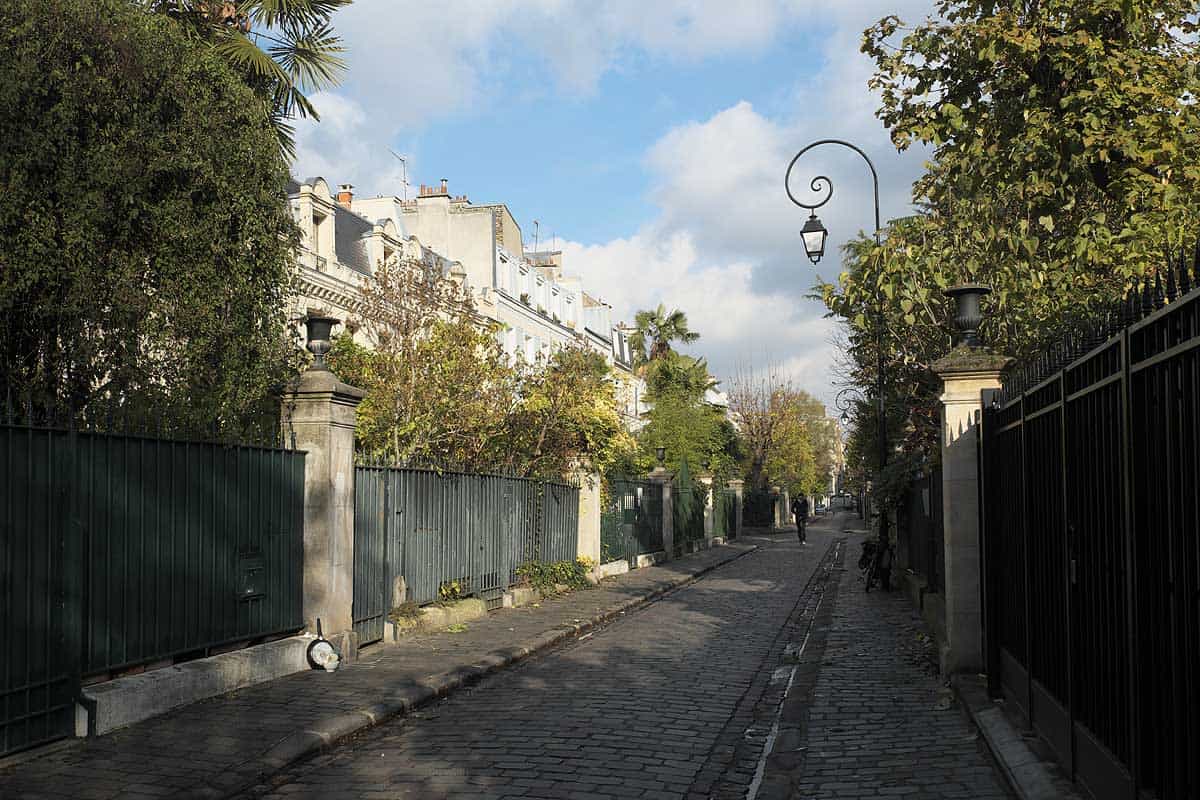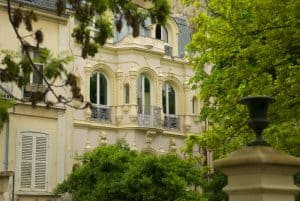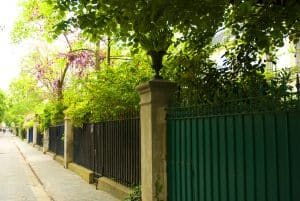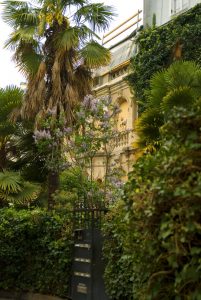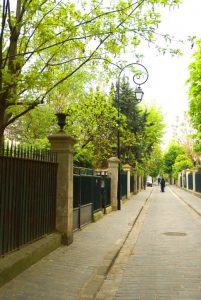The Cité des Fleurs lives up to its name! A charming pedestrian alley in the northern part of the 17th arrondissement, in the Epinettes district, it links Avenue de Clichy to Rue de la Jonquière, and is a favorite with local residents, who don't hesitate to make a detour morning and evening on their way to work or home...
Over its 320-meter length, it offers strollers a multitude of pretty villas set off by well-arranged gardens. Closed to public traffic, with a wide variety of facades and a peaceful atmosphere, the Cité des Fleurs generates a friendly village atmosphere right in the heart of Paris.
Its creation
In 1846, Ernest Gouïn founded his own company, eponymously named "Ernest Gouin et Cie", in the small village of Les Batignolles, north of Paris. He specialized in the construction of locomotives and spinning machines. The company grew steadily, soon employing 2,000 people.
Faced with this growing company and the promise of a peaceful future for the village, two investors, Jean-Edmé Lhenry and Adolphe Bacqueville de la Vasserie, decided to buy two hectares of land to be subdivided at a place called "Le chiendent", near the village. The site was located between today's rue de la Jonquière and avenue de Clichy. At the time, the area was still outside the Thiers city walls, sheltered from the industrial activity generated in the surrounding area.
Notary Auguste Balagny, also mayor of Batignolles-Monceau, accompanied the property transaction. In 1847, the two purchasers agreed on a set of architectural rules that were non-derogable for future owners - see paragraph on conventions - and named their development "Villa des Fleurs", followed in 1850 by "Cité des Fleurs". Faced with such an attractive name, the quackgrass was quickly forgotten.
In the meantime, the goods station, the gasworks on Avenue de Clichy and the Gouin factory across the street have evolved further, making the area noisy and hectic. Despite its charming name, Cité des Fleurs attracts few residents.
However, 16 years later, all the land had been purchased. And 3 years later, the painter Sisley illustrated the landscape offered by the Cité des Fleurs. His painting "Montmartre from the Cité des Fleurs" shows just how deserted the landscape still seemed...
Conventions
To preserve the village's much-appreciated authenticity, Lhenry and Bacqueville de la Vasserie quickly established two agreements.
The first, decided in 1847, was the creation of the Villa des Fleurs subdivision; the land purchased by the two buyers had been divided into five parallel strips. The initial plan was for small, two-storey terraced houses, with a small town garden framing a central alley punctuated by three circular squares.
The second, in 1850, presents and details the urban planning and architectural rules for the Villa, renamed Cité des Fleurs at the same time. Maximum two storeys and attic, aligned facades, gates and low walls of equal height, use of private and communal spaces, gates surmounted by a Medici vase created from a unique model...
However, as all the plots were bought by people from very different backgrounds, the Cité des Fleurs features a diversity of house styles: complex architecture and elaborate villas rub shoulders with more modest pavilions. But all have the distinctive feature of being flower-filled and pleasing to the eye, creating a harmonious effect despite this diversity.
Initially serving as a key document in the statutes of the 1901 association, bringing together owners from 1907 to 2010, these conventions still serve as a reference for the new statutes evoked by the Association Syndicale Libre de la Cité des Fleurs, which come into force on January 1, 2011. Like the conventions, these statutes define identical architectural and town-planning rules, and also contain the rights and duties in force for both residents and the public.
Its development
We mentioned above the diversity of house styles in Cité des Fleurs. This is proof of the social mix seen in this area. Even today, every social category is represented among Cité des Fleurs residents. But these differences are far from being a source of conflict - on the contrary.
The very example of this diversity can be traced back to the industrial era of the 19th century, when the railroad activity of the factories in the Cardinet district led to the arrival of a number of engineers, who decided to build their well-to-do homes in the Cité des Fleurs. Then the Gouin factory staff moved into a large pavilion. Their arrival triggered a series of infrastructure projects shared by the Cité's inhabitants: a crèche for the Compagnie des Chemins de fer de l'Ouest, followed in 1857 by the founding of the syndicat des propriétaires, which systematically brought together all new buyers. In this way, each owner also acquired rights and duties over the Cité.
Little by little, various decisions were taken in common: the recruitment of a janitor, the introduction of regulations defining the rights and duties of owners, a lighting and paving policy, the obligation for each owner to contribute to common expenses, the connection of the Cité des Fleurs to the Paris sewer system and, later, the installation of a sewage system.
In 1909, construction work began on Saint Joseph des Epinettes church, at no. 59 Cité des Fleurs. A presbytery, parish premises and a religious congregation were created. The church was completed in just over a year, and fitted with an organ by Cavaillé-Coll, the famous manufacturer of prestigious organs. In Paris, the largest churches, including La Madeleine, Saint Sulpice, Saint Denis, the Panthéon and Notre Dame Cathedral, were also equipped with Cavaillé-Coll organs. The organ at Saint Sulpice has 100 stops, making it the largest organ in France!
In 1942, actress Françoise Dorléac was born in the Cité des Fleurs clinic, and a year later, her sister Catherine Deneuve was born there.
A dramatic anecdote from the Resistance...
During the Second World War, no. 25 Cité des Fleurs was home to the Resistance's Centre de Fabrication de Faux papiers. This clandestine network was called "Plutus", and its members created and transmitted false papers for the National Liberation Movement in Lyon.
In May 1944, less than a month before the Normandy landings, the Gestapo discovered this network, invaded the pavilion at n°25 and immediately deported the members, except for the leader, Colette Heilbronner, who was executed on the spot. The other members died in the camps. A commemorative plaque on the gate of n°25 lists the members of the network.
The young workers' hostel
After the Liberation, a social phenomenon took hold in France, and particularly in Aveyron. Many young inhabitants headed for the capital. Statistically, in 1950, two young Aveyronnais a day left their territory, with no ties, and arrived in Paris, in the same unstable situation. They began to gather in cafés and, with team spirit playing its part, almost all found work. They decided to stay together to support each other through the exodus, and jointly bought a house at no. 30 Cité des Fleurs. With the arrival of young people from two other regions, the house became the "Foyer des Jeunes Aveyronnais, Cantaliens, Lozériens de Paris" in 1957. In 1963, it was renamed the "Foyer de Jeunes Travailleurs de la Cité des Fleurs". Since its creation, the hostel has housed some 5,000 young workers.
The centenary of the City of Flowers
For several months now, Jean Thoretton, Chairman of the Administrative Committee of the owners' association, has been organizing the celebration of the owners' association's 100th anniversary. Over 3 days, various artists who live or have lived in the Cité des Fleurs will perform for the owners. It's a traditional family celebration between close-knit neighbors, which takes place every year, and is perhaps even the origin of Neighbors' Day. But this year, on June 22, 23 and 24, the celebration will be longer, more festive and livelier. The centenary of a union that has achieved so much together needs to be celebrated appropriately!
La cité des fleurs today
La Cité des Fleurs now has 62 owners, divided into 32 individual properties and 20 condominiums managed by professional trustees or volunteers. The system of rights and duties for each owner, decided by the agreements, leads the residents to get really involved in the upkeep and improvement of the thoroughfare, and to do so on a voluntary basis. But their efforts are richly rewarded: the Cité des Fleurs is now a peaceful thoroughfare, full of discreet flowery details, and beautiful every season of the year.
Public access is possible from 7:00 a.m. to 7:00 p.m. Monday to Saturday, and from 7:00 a.m. to 1:00 p.m. Sundays and public holidays.
